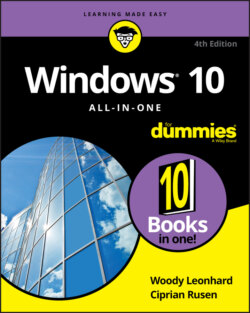Читать книгу Windows 10 All-in-One For Dummies - Ciprian Adrian Rusen, Woody Leonhard - Страница 59
The Start menu
ОглавлениеUnless you’ve been living on an alternate Windows desktop, you know that Windows 10 sports a new Start menu, with shortcuts on the left, a list of all your apps and programs in the middle, and Windows 8–style tiles on the right.
Figures 2-2 and 2-6 earlier in this chapter show the Start menu. In Figure 2-9, I show you the Start menu with the phone-dialer style index; you get to it by clicking the Start icon and then clicking one of the headings for the app groups (A, B, and so on).
You have very few customizing options for the Start menu — for example, you can’t drag entries onto the Most Used list in the top left, or drag items from the list on the left and turn them into tiles on the right. Tiles on the right can be resized to small (one-quarter the size of a medium tile), medium, wide (two single-size slots, as with the Store and Mail tiles in the screenshot), and large (twice the size of wide). You can click and drag, group and ungroup tiles on the right, and give groups custom names.
FIGURE 2-9: The Start menu, with the index that lets you jump to apps quickly.
You can resize the Start menu, within certain rigid limits. You can adjust it vertically in small increments, but trying to drag things the other way is limited to big swaths of tiles: Groups of tiles remain three wide, and you can add or remove only entire columns. You can drag tiles from the right side of the Start screen onto the desktop for easy access.
Although it’s possible to manually remove all the tiles on the right (right-click each, Unpin from Start), the big area for tiles doesn’t shrink beyond one column.
In tablet mode, Start looks quite different, although many of the options are the same. See Figure 2-10.
I talk about personalizing the Start menu in Book 3, Chapter 2 and working with tablet mode in Book 3, Chapter 3.
